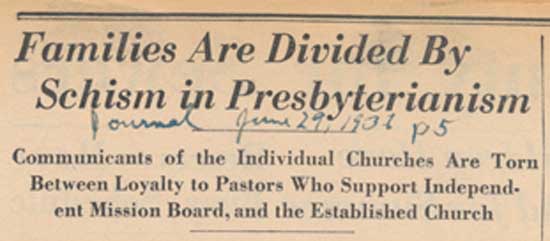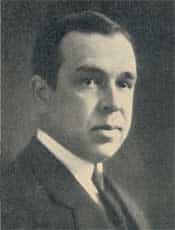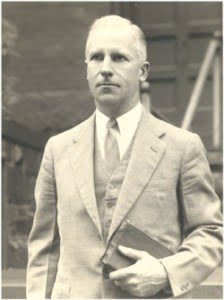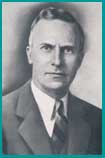Keeping in mind that newspapers were little different then than now, subject to the same human foibles*, nonetheless the following coverage of the modernist controversy and the resulting denominational split is interesting, as it offers some different perspectives on what a division means to those involved.
[*There are two errors mainly in the text below, both of which will be noted in brackets in their first appearance.]
This article is from a Wilmington, DE newspaper, dated June 29, 1936, and is found preserved in one of seven scrapbooks gathered by the Rev. Henry G. Welbon, covering the modernist controversy in the years 1935-1939. The photographs have been added and were not part of the original article.

Dissension with all the heartaches and strained loyalties that civil war brings, is definitely wedged in the Presbyterian Church in the U.S.A.
Where it will lead and the effect of the wedge, no one knows.
But this much is already evident in the Presbytery of New Castle, which embraced Delaware and parts of Maryland: families are divided, parents against children, husbands against wives, and friend with friend.
This is a time when members of congregations are torn between loyalty to their established church, when men are being accused of dogmatism, heresy, apostasy and free will.
Out of the seething cauldron has been born a new church, the Presbyterian Church in [sic; should be “of”] America, in contrast to the old Presbyterian Church in the U.S.A.
The nature of the wedge that is lodged in the church of the U.S.A. today is itself controversial.
Question Not Doctrinal
Those who are remaining loyal say the split is on a church constitutional question and among the loyalists are both fundamentalists and modernists.
“The matter now and never has been a controversy between ‘fundamentalists’ and ‘modernists’ the general council of the Presbyterian Church in the U.S.A. states.
It is a question the general council states, of whether ministers shall disobey the established constitution of a church and agree to the will of the majority.
The secessionists–all fundamentalists–say the differences are based upon doctrinal questions and liberty of conscience.
In any case, the immediate cause of the secession and the controversy has been the Independent Board of [sic; should be “for”] Presbyterian Foreign Missions, a board with no official connection with the Presbyterian Church in the U.S.A.
The leading personality in the Independent Board of Presbyterian Foreign Missions has been the Rev. Dr. J. Gresham Machen of the Presbytery of New Brunswick, N.J.
Four Judicatories in Church
For those not familiar with Presbyterian Church government, it should be explained that the judicatory and administrative bodies of the church are: First, the session, composed of representatives of a congregation, governing the church; second, the Presbytery governing a group of sessions in a district; third, the synod, a group of Presbyteries and fourth, the General Assembly which is the national ruling body of the Presbyterian Church which also is the supreme court and lawmaking body of the entire church.
Also as part of the story of the Independent Board of Presbyterian Foreign Missions is Pearl Buck, a missionary in China, whom it was charged was too much a modernist.
Dr. Machen Heads Movement
 Though she resigned, the charges persisted from the militant fundamentalists of the Presbyterian Church against the alleged modernism in the foreign mission groups. In 1933, Dr. Machen introduced into the Presbytery of New Brunswick a proposed resolution to be presented to General Assembly relating to what he called “modernism” in the Presbyterian Board of Foreign Missions.
Though she resigned, the charges persisted from the militant fundamentalists of the Presbyterian Church against the alleged modernism in the foreign mission groups. In 1933, Dr. Machen introduced into the Presbytery of New Brunswick a proposed resolution to be presented to General Assembly relating to what he called “modernism” in the Presbyterian Board of Foreign Missions.
A large majority of the Presbytery of New Brunswick refused to send this resolution to General Assembly but similar resolutions did reach General Assembly in 1933. The assembly received it and Dr. Machen was heard by the committee to which the resolutions had been presented for consideration.
By a vote of 43 to 2, the committee reported unfavorably and expressed its confidence in the Board of Foreign Missions and by a nearly unanimous vote, the General Assembly approved the report of this committee.
But Dr. Machen did not pause there. Accepting neither the views of the committee nor the “judgment of the General Assembly,” he was influential in the establishment of the Independent Board of Presbyterian Foreign Missions, incorporated in December of 1933, with Dr. Machen as president. It is not a recognized body of the Presbyterian Church in the U.S.A., being just what its name indicates, “independent.”
H. S. Laird Member of Board
 To this board came the Rev. Harold S. Laird, pastor of the First and Central Presbyterian Church of Wilmington, an ardent fundamentalist.
To this board came the Rev. Harold S. Laird, pastor of the First and Central Presbyterian Church of Wilmington, an ardent fundamentalist.
But before he joined the independent board, he consulted with his session. He did not join against their counsel.
Another point, not widely known, is that Mr. Laird during his pastorate at First and Central Presbyterian Church never solicited for the Independent Board of Presbyterian Foreign Missions.
“It was only after much earnest prayer and careful consideration,” he said, “that I came to the conviction that this movement was of God, and being thus convinced, I agreed to throw what little influence I have in the church to the lifting high of this standard. This was my primary motive in allowing myself to be elected a member of the Independent Board for Presbyterian Foreign Missions.
“It is from this board that I was ordered to resign. I believe the board is of God and I also believe that my call to membership on that board was of God. Under such circumstances, how can I resign? Shall I obey man rather than God?”
Taking note of this independent board and that ministers and elders were prominent in its membership, the General Assembly directed that all ministers and laymen affiliated with the board sever their connections with the organization.
Those who declined to obey this direction were ordered tried by their Presbyteries. A number were found guilty and either rebuked or suspended.
Mr. Laird tried before the Presbytery of New Castle, protested that his affiliation with the independent board had been guided by his conscience and that in refusing to sever his connection, he was placing the word of God above the courts of man.
Rebuked, But Not Suspended.
Mr. Laird, however, was found guilty, with one dissenting vote in his favor. He was ordered rebuked but allowed to remain [in] his pulpit.
But Mr. Laird continued in the membership of the independent board. The Presbytery recently suspended him from the ministry–an act regarded as illegal by Mr. Laird who immediately renounced the authority of the Presbytery.
Words to Live By
Unity is a precious thing, to be cultivated and prized. But Christian unity must be centered on the saving Gospel of our Lord Jesus Christ. Where we have that unity, it is glorious. Without Jesus Christ as our Cornerstone, there can be no Church.
Luke 12:49-53 (ESV)
49 “I came to cast fire on the earth, and would that it were already kindled!
50 I have a baptism to be baptized with, and how great is my distress until it is accomplished!
51 Do you think that I have come to give peace on earth? No, I tell you, but rather division.
52 For from now on in one house there will be five divided, three against two and two against three.
53 They will be divided, father against son and son against father, mother against daughter and daughter against mother, mother-in-law against her daughter-in-law and daughter-in-law against mother-in-law.”
Psalm 133 (KJV)
1 Behold, how good and how pleasant it is for brethren to dwell together in unity!
2 It is like the precious ointment upon the head, that ran down upon the beard, even Aaron’s beard: that went down to the skirts of his garments;
3 As the dew of Hermon, and as the dew that descended upon the mountains of Zion: for there the Lord commanded the blessing, even life for evermore.






![John Cameron Lowrie, D.D. [16 December 1808 - 31 May 1900]](https://thisday.pcahistory.org/wp-content/uploads/2012/05/LowrieJohnC.jpg)